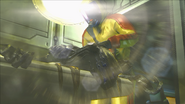Ethereal Autopsy is a research project in XCOM: Enemy Unknown.
In-Game Description[]
Proposal[]
| “ | This alien appears physically weak, even frail...but appearances can be deceiving. It is a remarkably hardy specimen, with a brain chemistry and structure utterly unknown to our science. | ” |
Initial Findings[]
| “ | This specimen appears to be at the top of the alien hierarchy, and for good reason. As you've probably seen, its physical form is not suited for combat by any means. However, these "Elders" have an incredible pool of psionic energy at their disposal, which helps to explain why the other species are subordinate to them. | ” |
Project Report[]
| “ | Codename: Aether
This specimen appears to be at the top of the alien hierarchy, and for good reason. As we've noted in the field, its physical form is not suited for combat by any means. Their bodies actually appear to be quite frail, with evidence of atrophy and muscular degeneration having occurred over an extended period of time. This is not surprising, as initial radiocarbon dating indicates this particular creature could be... several thousand years old. Unlike the other specimens we've examined, there is little to indicate that it was genetically enhanced, at least not with the same ambition as the others. Strangely enough, we have uncovered similarities between the "Ethereal" brain and that of the Sectoid Commander. Both show the same enhanced synaptic connections, confirming our suspicion that this is the likely source of their power. These Ethereals appear to have an incredible pool of psionic energy at their disposal... more than anything we've previously encountered, which helps to explain why the other species are subordinate to them. The Unit Analysis View should provide additional information about this creature's combat capabilities in the field. |
” |
Project Requirements[]
Prerequisites: Obtain Ethereal corpse
Research Point Cost: 120 Points
Project Cost: 1 Ethereal Corpse
Items Unlocked[]
Trivia[]
- It would be impossible to accurately date an extraterrestrial species using radiocarbon dating (which relies on the half life value of Carbon-14) without knowing the current and past concentrations of C-14 on the alien homeworld (assuming it is even naturally present in such an environment). Furthermore the carbon dating of living specimens can also result in unusual readings, given the fact that living species are not closed systems and as such are continually absorbing carbon or use C-14 poor material as the basis for exoskeletal growth or shells; as an example, snail shells incorporate material from the surroundings which could result in the shells containing levels of C-14 many times lower than the current standard.
Gallery[]
| XCOM: Enemy Unknown Research Projects | |
|---|---|
| Armor | Archangel Armor • Carapace Armor • Ghost Armor • Psi Armor • Skeleton Suit • Titan Armor |
| Autopsy | Berserker • Chryssalid • Cyberdisc • Drone • Ethereal • Floater • Heavy Floater • Mechtoid • Muton • Muton Elite • Sectoid • Sectoid Commander • Sectopod • Seeker • Thin Man • Xeno-Biology |
| Interrogation | Berserker • Ethereal • Floater • Heavy Floater • Muton • Muton Elite • Sectoid • Sectoid Commander • Thin Man |
| Technology | Alien Materials • Alien Nav Computer • Arc Thrower • Elerium • Ethereal Device • Experimental Warfare • Hyperwave Communication • Meld Recombination • New Fighter Craft • Outsider Shard • UFO Power Source • Weapon Fragments |
| Weaponry | Alloy Cannon • Beam Weapons • EMP Cannon • Fusion Lance • Guided Fusion Launcher • Heavy Lasers • Heavy Plasma • Light Plasma Rifle • Plasma Cannon • Plasma Pistol • Plasma Rifle • Plasma Sniper • Precision Lasers |



